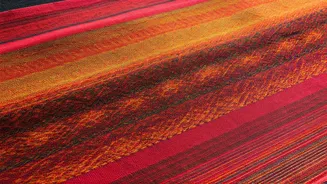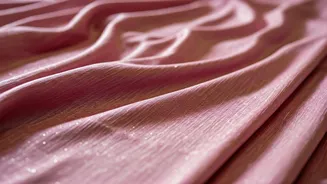Saree Storage Essentials
Proper storage is crucial for safeguarding sarees. Begin by ensuring each saree is thoroughly cleaned before storage. This prevents dirt and oils from
setting in and damaging the fabric over time. Opt for breathable storage options like cotton or muslin cloth bags, which allow air circulation and prevent moisture buildup. Avoid plastic bags, as they can trap humidity, leading to mildew and discoloration. When folding, use acid-free tissue paper between the folds to prevent creases and protect delicate embellishments such as zari or embroidery. Store sarees in a cool, dark, and dry place, away from direct sunlight and heat sources, which can fade colors and weaken fibers. Periodically check your stored sarees for any signs of damage, such as insect infestations or stains, and address these issues promptly. This proactive approach helps extend the life and elegance of your treasured sarees.
Cleaning for Longevity
The cleaning of sarees plays a pivotal role in maintaining their allure and longevity. Always consult the care label for specific instructions, as different fabrics require different treatments. Delicate fabrics like silk and chiffon often require dry cleaning, a method that uses solvents to remove dirt without water exposure. If hand washing, use cold water and a mild detergent specifically designed for delicate fabrics. Avoid harsh chemicals and excessive scrubbing, which can damage the fabric's structure and fade colors. Gently agitate the saree in the water and rinse thoroughly until all traces of detergent are gone. When drying, avoid direct sunlight and hang the saree in a shaded area or lay it flat on a clean surface. For sarees with embellishments, such as beads or sequins, consider professional cleaning to avoid damaging these delicate elements. Promptly address any spills or stains to prevent them from setting into the fabric. By following these cleaning guidelines, you will preserve the vibrancy and beauty of your sarees for many years to come.
Spotting & Stain Removal
Knowing how to handle spots and stains is key to keeping sarees pristine. Act fast when a stain appears, as the quicker you act, the more likely you are to remove it completely. Identify the type of stain to choose the most effective removal method. For oil-based stains, gently blot the area with a clean cloth or tissue to absorb excess oil. Then, sprinkle cornstarch or talcum powder on the stain, let it sit for a few hours to absorb the oil, and brush it away. For water-based stains, such as coffee or tea, gently blot the stain with a clean, damp cloth. Avoid rubbing, as it can spread the stain. If the stain persists, consider using a mild stain remover suitable for the fabric type. Always test the remover on a hidden area of the saree first to ensure it doesn't damage the fabric or fade the color. For ink stains, consult a professional cleaner. Professional cleaning ensures that specialized stain removal techniques are employed to protect the saree and restore its appearance.
Addressing Common Issues
Sarees can encounter various issues, and knowing how to address them helps maintain their condition. Color bleeding, which can occur during washing, can be prevented by washing similar colors together and using color-catcher sheets. If color bleeding occurs, wash the saree again with a color-fixing agent. Fading, caused by sunlight or improper washing, can be minimized by storing sarees in a dark place and avoiding harsh detergents. If fading occurs, consider a professional color restoration service. Insect infestations, like moths, can damage silk and other natural fibers. Prevent this by storing sarees in airtight containers with cedarwood or lavender sachets, which act as natural repellents. Loose threads or minor tears can be repaired using fine needles and threads that match the original fabric. For more significant damage, consult a professional tailor or seamstress. By being prepared to address common saree issues, you can preserve the value and beauty of your cherished sarees.
Professional Care's Benefits
Professional care is often the best option to keep sarees in optimal condition. Professional dry cleaners have the expertise and specialized equipment to handle delicate fabrics and intricate embellishments. They use specific solvents that effectively remove dirt and stains without damaging the saree. Professional cleaning also ensures that sarees are properly pressed and finished, restoring their original shape and luster. Many dry cleaners offer specialized services, such as stain removal and color restoration, providing solutions for a variety of saree issues. Regularly using professional cleaning services can prevent minor issues from becoming major ones, extending the saree's lifespan. Professional cleaners may also offer storage solutions, ensuring that your sarees are properly stored in a climate-controlled environment, minimizing the risk of damage. Investing in professional care not only preserves the beauty of your sarees but also protects your investment for future enjoyment.









